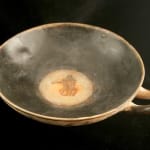Black-Figure Terracotta Kylix, 6 Century BCE - 5th Century BCE
Terracotta
10 x 3.125 x 7.5
CK.0662
Before the modern advents of trains and automobiles, trade between civilizations concentrated around the Mediterranean moved foremost by sea. While many bulk commodities such as timber and stone could be...
Before the modern advents of trains and automobiles, trade between civilizations concentrated around the Mediterranean moved foremost by sea. While many bulk commodities such as timber and stone could be loaded directly aboard a ship with little preparation, other commodities such as spices, wine, and grain needed to be packed in individual containers for transport both at sea and on land and to prolong their life span. Pottery was first created in order to fulfill these practical needs. Over time, the art form evolved from large, unadorned commercial transport vessels to refined, specialized works in elegant shapes used to hold precious substances such as perfume or oils.
An entire retinue of terracotta vessels dedicated to the rites of the dinner table began to appear. These pieces were based on the luxurious bronze and silver vessels that could only be afforded by the wealthy elite and were decorated with fanciful natural motifs and painted scenes of everyday life and celebrated myths. These wares were of such beauty that they themselves became prized commodities and were traded throughout the Mediterranean world; perhaps even for the very substances they were created to contain. These works are individually classified by their shapes and their form was inherently linked to their function, be it preparation, dispensation, or consumption.
The majority of the pots were thrown on a manually driven potter’s wheel and fired in a wood-burning kiln where the artist could determine the color of the vessel by controlling the oxygen flow within. While many potters threw and painted their own works, certain potters excelled in producing specific shapes, and other artists specialized in painting. Before the 6th Century B.C., the island of Corinth, with their distinctive black-figure wares that first appeared in the 7th Century, dominated the lucrative pottery export trade.
An entire retinue of terracotta vessels dedicated to the rites of the dinner table began to appear. These pieces were based on the luxurious bronze and silver vessels that could only be afforded by the wealthy elite and were decorated with fanciful natural motifs and painted scenes of everyday life and celebrated myths. These wares were of such beauty that they themselves became prized commodities and were traded throughout the Mediterranean world; perhaps even for the very substances they were created to contain. These works are individually classified by their shapes and their form was inherently linked to their function, be it preparation, dispensation, or consumption.
The majority of the pots were thrown on a manually driven potter’s wheel and fired in a wood-burning kiln where the artist could determine the color of the vessel by controlling the oxygen flow within. While many potters threw and painted their own works, certain potters excelled in producing specific shapes, and other artists specialized in painting. Before the 6th Century B.C., the island of Corinth, with their distinctive black-figure wares that first appeared in the 7th Century, dominated the lucrative pottery export trade.



